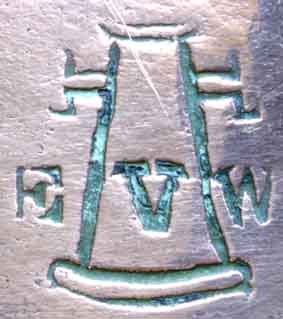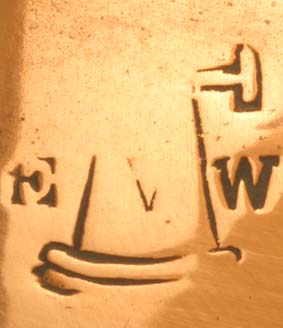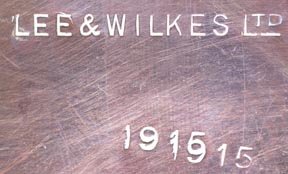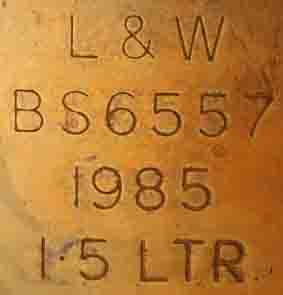E V Wilkes Co
(c) Antique Metalware Society
Small extracts can be used with acknowledgements to 'Oldcopper.org' website.
Helpful comments are very welcome.
EVW – Wilkes, Edward Villers, 12, Lower Priory, near Colmore Circus, Birmingham, from pre-1829 - (Slater’s Directory, 1852). By 1884 they were at Priory Copper Works, Brewery Street, New Town Row.  The name is not found in directories after the 1907 merger with Charles Lee to form Lee and Wilkes, Brewery Street which continued up to c1939 but use of the trade mark may have continued after 1907. Part of the family may have founded John Wilkes, Sons and Mapplebeck Ltd (c1885) of Adderley St. Birmingham who continued as Mapplebecks until the late 20th century.
The name is not found in directories after the 1907 merger with Charles Lee to form Lee and Wilkes, Brewery Street which continued up to c1939 but use of the trade mark may have continued after 1907. Part of the family may have founded John Wilkes, Sons and Mapplebeck Ltd (c1885) of Adderley St. Birmingham who continued as Mapplebecks until the late 20th century.
Wilkes is originally described in 1818 as a manufacturer of casting pots, crucibles and ovens in Upper Temple Street. Later descriptions list him as a wholesale & warming pan maker, wholesale brazier, coppersmith, pewterer, and dealer in metals. Trade Mark ‘EVW’ across a milk churn, found on kettles, coppers, saucepans and other copper kitchenware.
'The firm started as a coppersmiths run by Messrs. Birch and Villiers. William Villiers, a wealthy magistrate, took on an apprentice to the firm by the name of Wilkes. Wilkes married Villiers’ daughter and was taken in as a partner in the firm in 1818, and by 1825 the firm was known as Villiers & Wilkes. The business had a number of premises changes over the years, from Moor Street to the Old Square to Brewery Street and Newtown Row, all in Birmingham. In 1907 the firm amalgamated with Charles Lee of Freeman Street to become Lee & Wilkes Ltd.' (ack Paul Buxton)
 Slightly better detail is seen in this version although the upper part is missing. This is a frequent problem eithert due to uneven striking of the punch or over enthusiastic polishing. This company put their mark is in an unusual position just behind the spout of a kettle body, just behind the spout, rather than in the usual position on the base where it could get burnt away. The kettle is of mid to late 19th century manufacture with a cramped (dovetailed) base.
Slightly better detail is seen in this version although the upper part is missing. This is a frequent problem eithert due to uneven striking of the punch or over enthusiastic polishing. This company put their mark is in an unusual position just behind the spout of a kettle body, just behind the spout, rather than in the usual position on the base where it could get burnt away. The kettle is of mid to late 19th century manufacture with a cramped (dovetailed) base.
 Wilkes mark on a frying pan (skillet) made by Wilkes and sold by Harrods of London. (Photo courtesy Chris Cope).
Wilkes mark on a frying pan (skillet) made by Wilkes and sold by Harrods of London. (Photo courtesy Chris Cope).
'I've been researching the Wilkes family (my great-uncle was Gilbert Wilkes [1867-1948], whose childhood home was Chadwick Manor, Balsall). I note that Edward Villers Wilkes is said to have been an apprentice of the magistrate, William Villers, and married to his daughter. William Villers was the brother of Hannah Villers, who married Edward Wilkes in 1771. Their son, Edward Villers Wilkes, born in 1781, thus seems to have been Villers's nephew. His elder brother, John, heads a direct line which includes the partners of John Wilkes & Sons, founded in 1824, whose copper rolling mills at Bordesley provided enormous amounts of wiring for the Atlantic cable projects of 1857-8 and 1863. One of the family later founded John Wilkes & Mapplebeck (his son-in-law, incidentally), which, combined with the earlier partnership, was floated on the stock market in 1892.' Andrew Rose

Advertisement for the family firm of John Wilkes and Maplebeck mentioned above.

Mark of Lee and Wilkes Ltd under a copper jug dated 1915, during the 1914-1918 war. All materiel supplied for defence requirements has to be identified and dated.

Under a thermally efficient copper kettle made to British Standard in 1985 is the 'L&W' mark of Lee & Wilkes.
Part of their exhibition stand at Olympia in 1938 showing that the traditional kettle was still one of their major products. (Photo courtesy Keith Pinn)